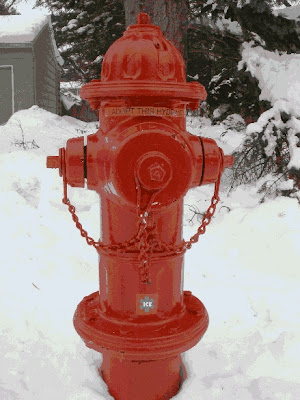Hydrant sorely in need of help here....vines too! Houses across the street.
A Cicero NY firefighter responded to our notice rescuing this fire hydrant!
Winter is no time to hibernate when it comes to preparedness and fire safety especially...while you are out shovelling, snow blowing or plowing, please take a few minutes to remove obstructions (SNOW) around your nearby fire hydrant. If you live in a fire district with volunteers remember it may take extra time for them to respond to your fire....those 10 minutes will seem like an eternity. Why have them waste even more time shovelling to your hydrant?
Update 12-12-10: We've added a zipped file of posters on the main page of the website and Adopt A Hydrant Certificate files so your FD can create their own posters and let people "adopt" a hydrant for the purposes of ensuring it is clear of any obstruction (snow) in the event of a fire..... check them out.... http://www.ice4safety.com/
Having an obstructed hydrant could result in a delay in knocking down your fire and the sacrifice of 1-2 firefighters that might be better used fighting the fire or doing a rescue...now think about that. Don't wait.
Get the latest Winter Fire Safety Kit for your organization right here: 12-27-10
We try to support those who will be responding to our calls for help and have done so for years. This idea is certainly timely and important - especially in this retched economy where the cost of services keep going up and the level of service keeps going down.
Okay here is a hydrant in DEWITT, NEW YORK shoveled out recently(okay, we used a snow blower!) so even a Fat Santa can get around this one ....or a heavily outfitted firefighter. 10 feet of clearance all around so the snow plow won't block it in. Don't scrimp here. Teach the kids how to do it.
Suggestions: Town/Village/City could place a family (or families) name on the hydrant that is charged with clearing it out (See Pics) using easily applied label tape or they can implant a locater stake with a flag with the names on it.....and keep a spreadsheet database of names.....contests or business sponsorship (they can clean out theirs as well) are all possibilities. We have included an "Adoption Certificate" in our Fire Safety Zipped File so Fire Chiefs or sponsors can issue them to willing participants.....which should be everyone. This goes for dry standpipes in rural communities as well.
Snowstorm predicted for this week.....get your shovel on!
Adopt This Hydrant.
Fire Chiefs or Town/City Officials Can Issue "Adoption Papers"
NEW!.....Notify your local Fire Department yourself that you are Helping Out!
Steve Cannerelli Photo Syracuse Post Standard 1-19-11 ISO Rated #1 Fire Department
WIXT News and B104.7 Radio Have Joined the Chorus 2-9-11
Is this as easy as it seems? Yes it is....
ICE4SAFETY has expanded to Wordpress now as well.....



